UNIT 2
Ecosystems
Concept of an ecosystem
Term ‘Ecosystem’ was tossed in the year 1935 by an English Botanist- A.G. Tansley.
An ecosystem is a geographic area which contains both Biotic as well as Abiotic factors and their interaction with each other.
There are various types of Ecosystems such as:
- Terrestrial
- Aquatic
- Desert
- Grassland
- Forests
- Marine
- Freshwater, etc.
Structure and function of an ecosystem
Ecosystem has 2 major components:
1) Biotic (Living)
2) Abiotic (Non- Living)
These 02 components when interacts with each other in a system, then give rise to an ecosystem.
Biotic Components are of 3 further types:
1) Producers
2) Consumers
3) Decomposers
Abiotic Components are of 3 sorts:
1) Climatic Factors (Rain, Lightning, Humidity, Wind, Temperature, etc.)
2) Edaphic Factors (Soil based factors such as pH, minerals, etc.)
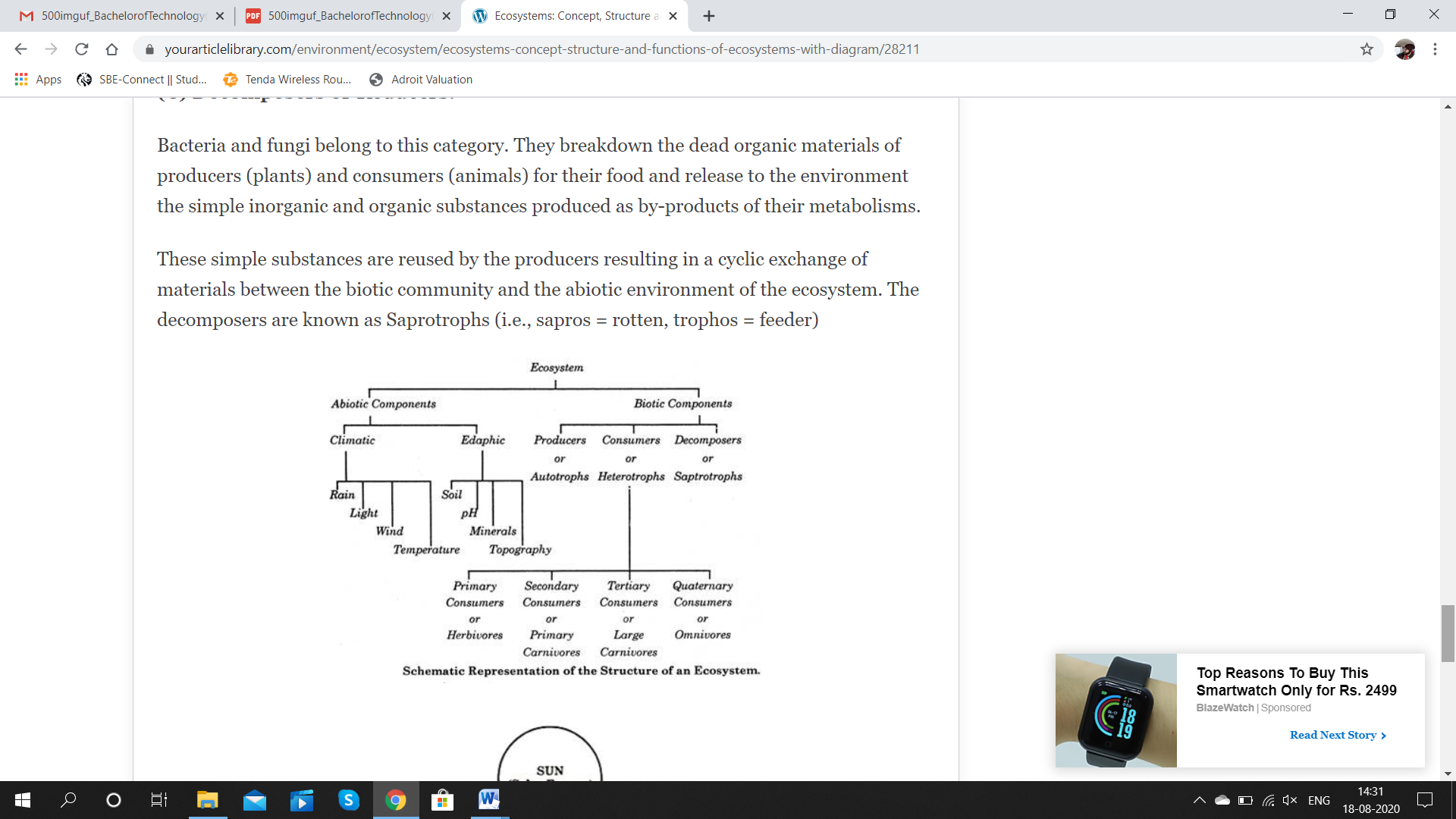
Classification of Ecosystem and its components
Functions:
Basic function of ecosystem is merely an exchange of energy and nutrients in the food chain which impacts the survival of existence of all life forms. This exchange is responsible for the setting up of equilibrium between biotic and abiotic components.
The behavior of energy in ecosystem can be conveniently termed as energy flow because of unidirectional energy transformations. Total energy flow that constitutes the energy environment has already been dealt in detail, and now we take up the study of that portion of the total energy flow that passes through the biotic components of the ecosystem. Entrance of energy, its retention within the ecosystem and dissipation into space, are governed by two laws of thermodynamics. According to the first law, the law of conservation of energy, in a closed system, no energy comes in or escapes out and not created or destroyed but may be altered from one form to another. The second law of thermodynamics, the law of entropy, states that there is always a tendency for increase in entropy or degradation from a concentrated (non-random) to a dispersed (random) form leading to dissipation of heat. All the energy entering the earth’s surface can be accounted for. Some energy is used in photosynthesis; the rest is used in converting the water into vapours or heating the soil and air. Ultimately the energy reflected back to outer space as heat. The light energy fixed by green plants in the process of photosynthesis may be represented by the following equation:
Out of the amount of energy so fixed by green plants, some is released again in respiration. The fixed energy, in the form of food, then passes from plant source through herbivores to carnivores. At each stage of food transfer, potential energy is released, resulting in further loss of a large part of energy. The energy flow, thus follows the second law of thermodynamics.
Ecological succession is the phenomenon or process by which an ecological community undergoes more or less orderly and predictable changes following disturbance or initial colonization of new habitat. Succession was among the first theories advanced in ecology and the study of succession remains at the core of ecological science. Succession may be initiated either by formation of new, unoccupied habitat (e.g., a lava flow or a severe landslide) or by some form of disturbance (e.g. Fire, severe wind throw, logging) of an existing community.
- Primary succession
Succession that begins in new habitats, uninfluenced by pre-existing communities is called primary succession. In primary succession pioneer species like lichen, algae and fungus as well as other abiotic factors like wind and water start to "normalize" the habitat. This creating conditions nearer optimum for vascular plant growth; pedogenesis or the formation of soil is the most important process.
These pioneer plants are then dominated and often replaced by plants better adapted to less odd conditions, these plants include vascular plants like grasses and some shrubs that are able to live in thin soils that are often mineral based.
For example, spores of lichen or fungus, being the pioneer species, are spread onto a land of rocks. Then, the rocks are broken down into smaller pieces and organic matter gradually accumulates, favouring the growth of larger plants like grasses, ferns and herbs. These plants further improve the habitat and help the adaptation of larger vascular plants like shrubs, or even medium- or large-sized trees. More animals are then attracted to the place and finally a climax community is reached.
2. Secondary succession
Succession that follows disruption of a pre-existing community is called secondary succession. (e.g. Forest fire, harvesting, hurricane) that reduces an already established ecosystem (e.g. a forest or a wheat field) to a smaller population of species, and as such secondary succession occurs on preexisting soil whereas primary succession usually occurs in a place lacking soil.
1) Food Chains:
Food chains were first introduced by the African-Arabic scientist and philosopher Al-Jahiz in the 9th century but got popularized by Charles Elton in the year 1927.
It is defined as an order of living organisms in a community in which continuous consumption of one organism by other organism and so on takes place.
It can be stated as a chain of organisms in their natural surroundings, through which energy is transferred.
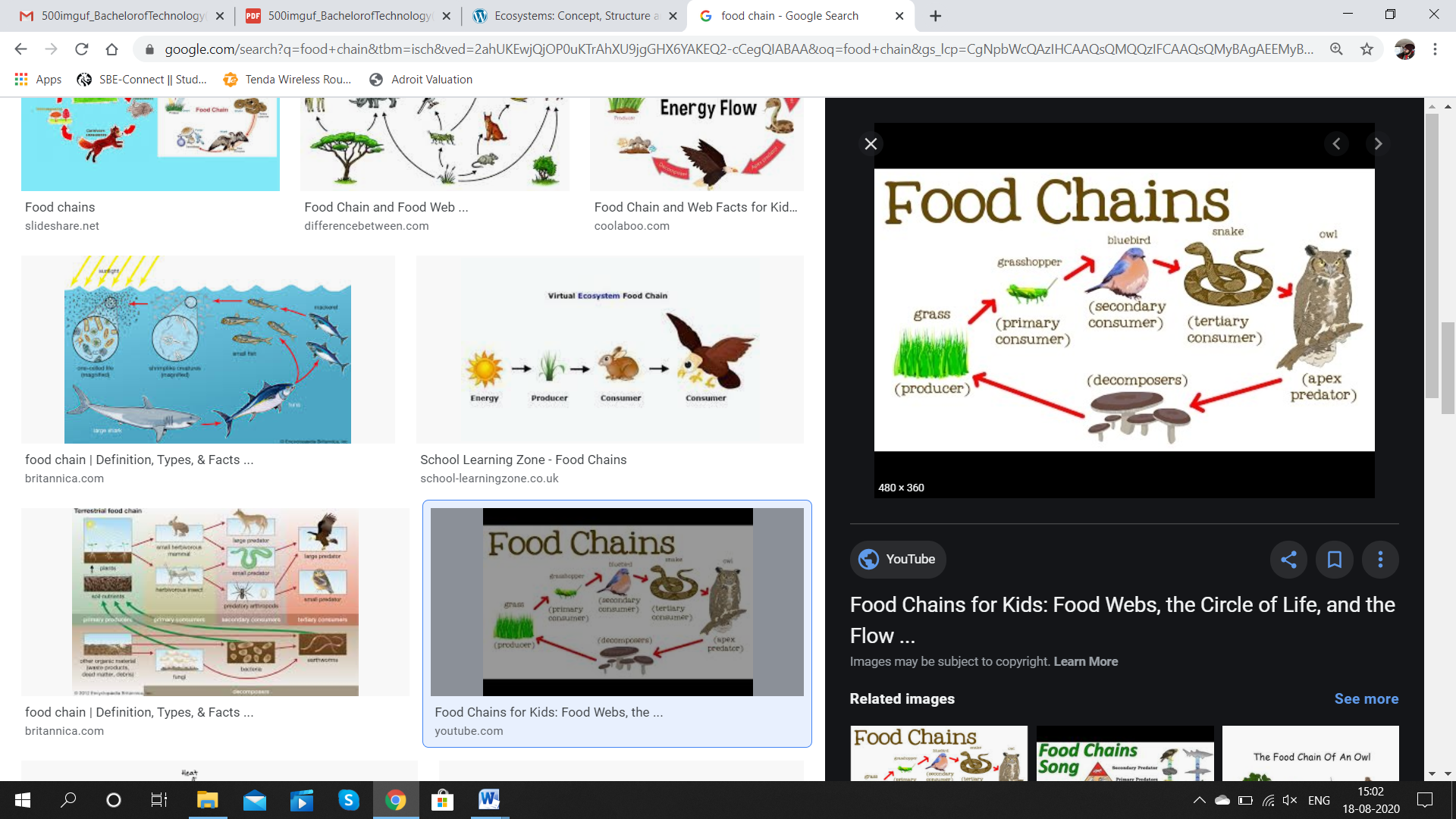
A typical Food Chain comprises of producers, consumers and decomposers.
2) Food Web:
A food web may be defined as a graphical representation depicting interconnection between various food chains.
.
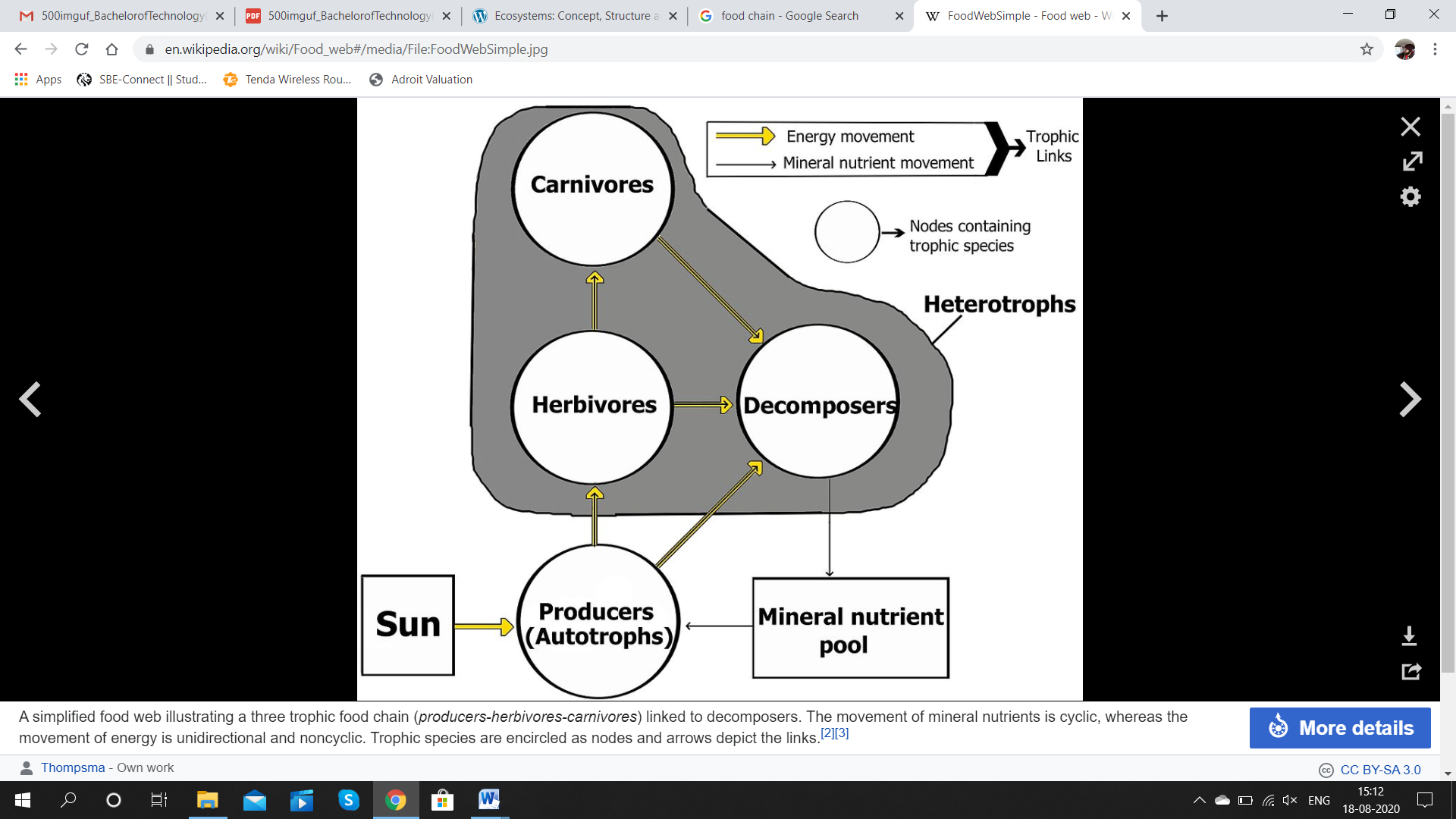
Simplified Food Web depicting energy movemet and nutrient flow between 3 basic food chain components (Carnivores, Herbivores & Decomposers)
As a food web contains a number of interconnected food chains, hence it results in a complex structure.
Whenever various food chains form such a structure by overlapping each other, it results in generation of a Food Web.
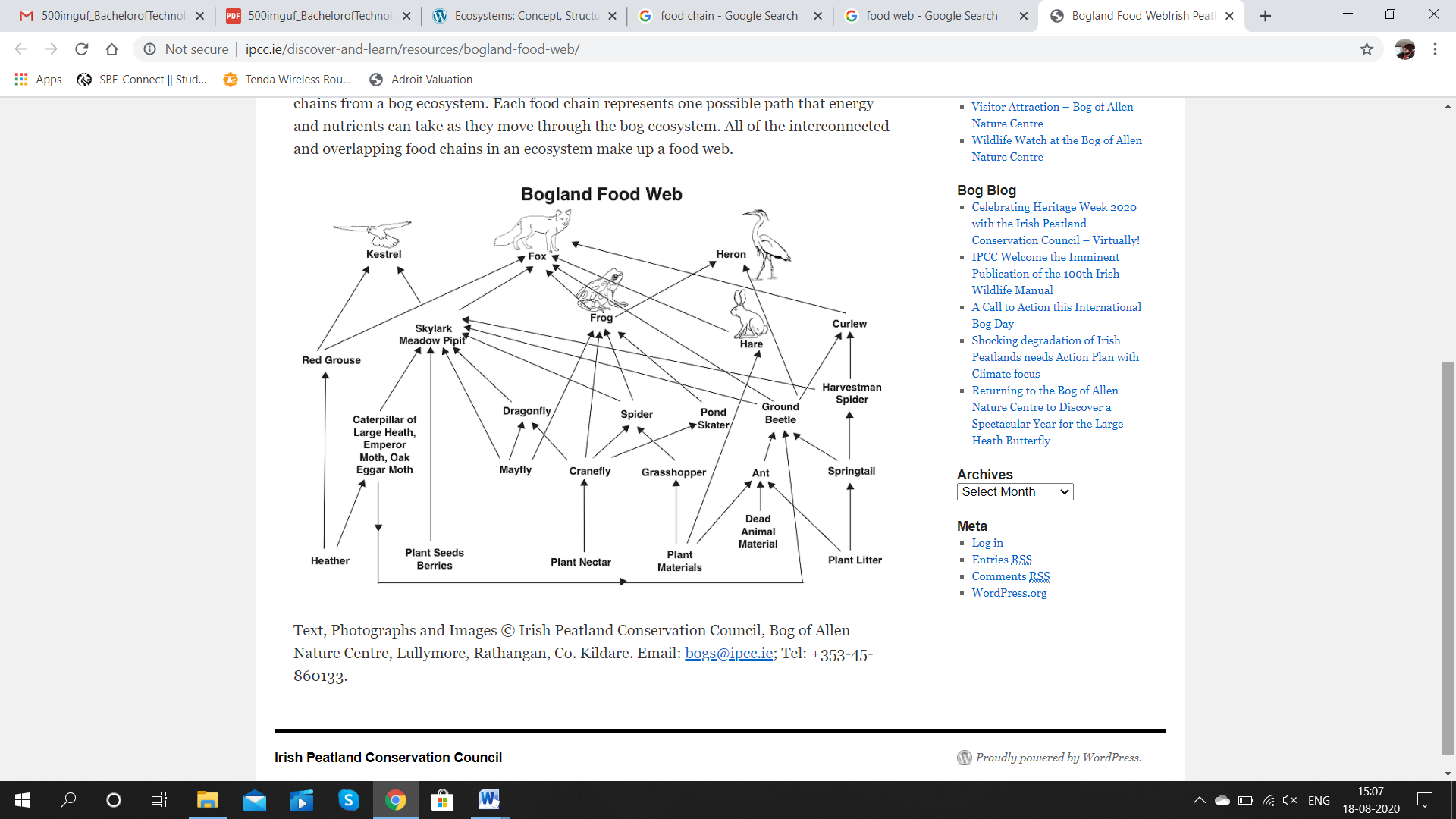
A complex food web
Forest ecosystem
A terrestrial environment consisted and dominated by trees growing in a closed system is called as a forest.
So, a scientific study of interrelated processes, patterns of flora, fauna and their surroundings in a forest is stated as Forest Ecosystem.
- Case: Chunati Wildlife Sanctuary (CWS), Bangladesh
Forest Resource Collection is the significant employment choice for larger part of the individuals living in or around the Chunati Wildlife Sanctuary (CWS), Bangladesh.
The study helped to identify the nature and sorts of forest resources, their collection and quantification in order evaluate the value of the amount of forest resources collected by different resource collectors. Market based approach was being used to estimate the value of the collected resources. Interviews of the resource collectors and multiple checking of the selling price of that particular resource from the adjacent local markets was criteria used for it
A total of 28 forest trails (used by the local communities as entry or exit points for forest resource collection) out of 56 were selected proportionately from two forest ranges (12 from Chunati and 16 from Jaldi) and from all categories of forest trails based on frequency of use (heavily used, moderately used and less used) for the study.
The survey was conducted during the dry season (October to May) as it is found to be suitable for resource collection compared to wet season (June to September).
Result of the study shows that 481 resource collectors per day enter into the CWS through surveyed trails before noon and get back before evening of which 22% are female. Higher numbers of resource collectors were found to carry fuel wood (30%) followed by NTFP or fruits (13%), timber (11%), agricultural products (11%), bamboos or bamboo shoots (10%), sun grass (10%), etc.
The mode of carrying forest resources was by shoulder load (63%) followed by head load (30%). Among the resource collectors 84% are adult and the rest 16% are minor. The resource collectors spend 5.71 hours per day on average at the forests to collect resources and travel 6.41 km on average for each visit to the CWS.
The average value of the resources collected by each collector on each visit is BDT 301 (USD 3.71) which may be calculated as BDT 289,735 (USD 3,697.16) for the whole of CWS per day.
The findings of this study will give a better insight to the problem of forest degradation in Bangladesh and particularly in the CWS.
b) Grassland ecosystem
A grassland ecosystem is one which is dominated by non woody (herbaceous) plants and various types of grass.
- Case: Grassland of Middle South Inner Mongolia
In this study, we analyse the changes of indicators of ecosystem services and functions, in order to understand the main cause of grassland degradation due to climatic variation or land use changes in the middle-south Inner Mongolia.
The soil nutrient and the water supply of supporting service got recovery during 1988–2008. The loss of net primary production declined, and the quality of the retained unconverted grassland (RUG) even increasingly degraded from 2000 to 2008.
Analytical results show that environmental degradation on the land-use-changed-area is lower than that on the RUG from 2000 to 2008. It illustrates that climatic variation has more negative impacts on grassland ecosystem service, and which is significantly higher than the so-called “overgrazing” induced grassland degradation.
Moreover, it cannot be excluded that those species died out on the RUG due to natural selection or competitive evolution in an evolutionary process under the deteriorative weather condition rather than overgrazing.
The positive impacts of human activities such as conservation programs and wildlife protection laws also benefit to regional grassland ecosystem obviously in the study area, so that can delay the environmental degradation even if each planet has its life cycle.
It indicates that an integrated regional planning involving the considerations of climatic conditions, geographical characteristics, socioeconomic factors, and ecological functions and biodiversity can benefit to regional grassland conservation based on monitoring and management via scientific methods
c) Desert ecosystem
A desert is a barren land of landscaping area with very little precipitation (rain), lack of vegetation and very hostile living conditions for plant and animal life.
Case: The Western Desert, USA
The western desert covers an area of over 2 lacs sqkms in south-west USA.
It has 03 sub-deserts: Mojave, Chihuhuan and Sonoran.
It extends in the states of Arizona & California (USA) and some parts of New Mexico too.
Major Extractions done in this region are: Coal, Copper, Uranium, etc.
Due to its solar potentiality, it has a huge capacity to generate solar electricity.
Some oil reserves are also found here.
Peppers and grapes are few farming crops found in this region.
With around 30 million tourists per year, tourism is a key indicator of its economy.
Some challenges that are being faced in Wester Desert are as follows:
Extreme Temperature
Inaccessibility due to its vastness
Inadequate water supply
Very low rainfall
Hoover Dam, constructed on Colorado River is playing a crucial resource for counteracting irrigation and drinking problems.
d) Aquatic ecosystem (ponds, streams, lakes, rivers, oceans, estuaries)
‘Aqua’ means ‘water’. Hence, an ecosystem present in a body of water is called an Aquatic Ecosystem.
Types of Aquatic Ecosystems:
1) Freshwater Ecosystem
2) Marine Ecosystem
3) Transitional Communities
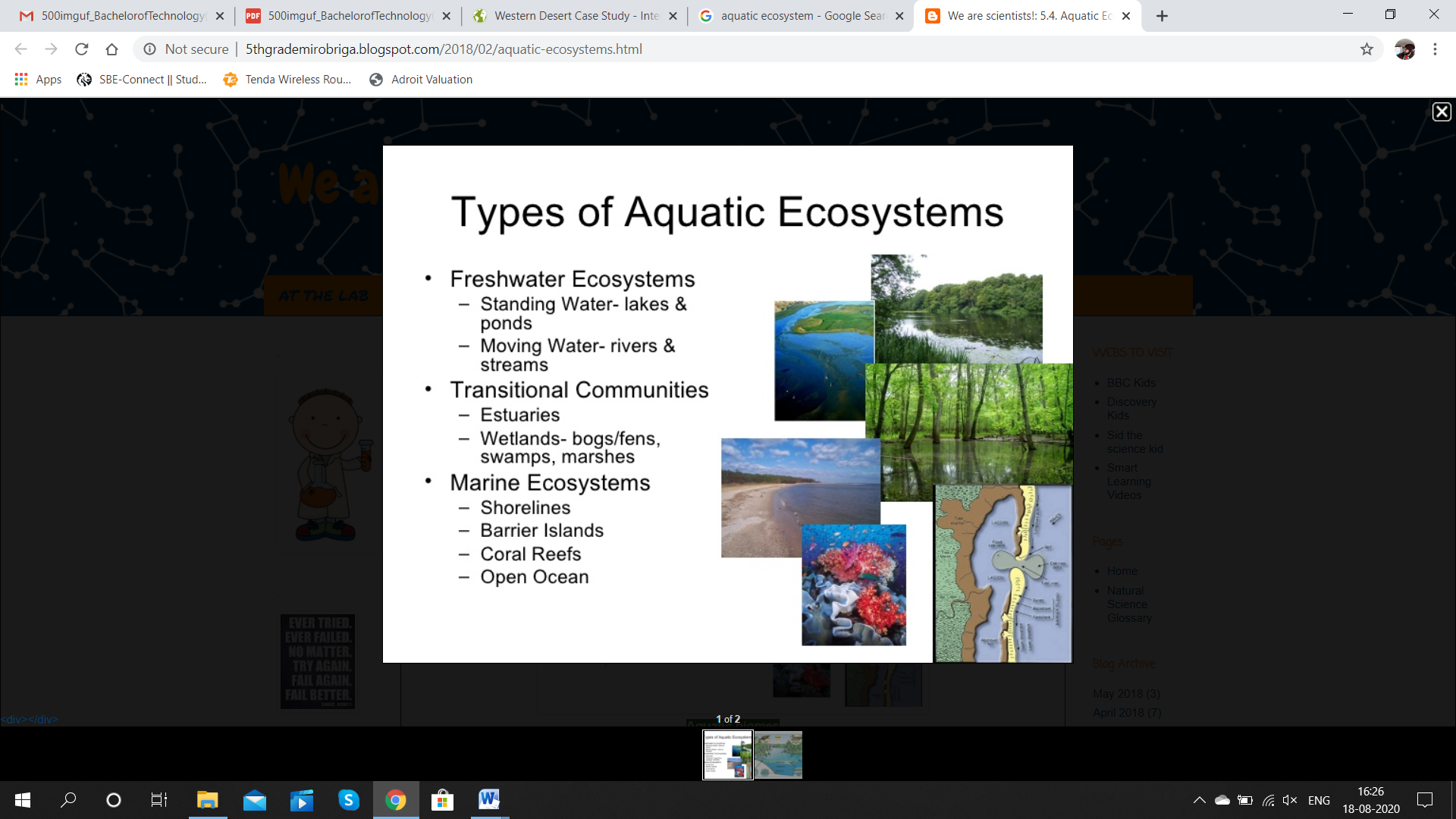
Classification of Aquatic Ecosystem
References :
- Textbook Of Environmental Science By Deeksha Dave And E.Sai Baba Reddy, Cengage
- Publications.
- Text Book Of Environmental Sciences And Technology By M.Anji Reddy, Bs Publication.
- Comprehensive Environmental Studies By J.P.Sharma, Laxmi Publications.
- Environmental Sciences And Engineering – J. Glynn Henry And Gary W. Heinke – Prentice Hall Of
- India Private Limited.
- A Text Book Of Environmental Studies By G.R.Chatwal, Himalaya Publishing House